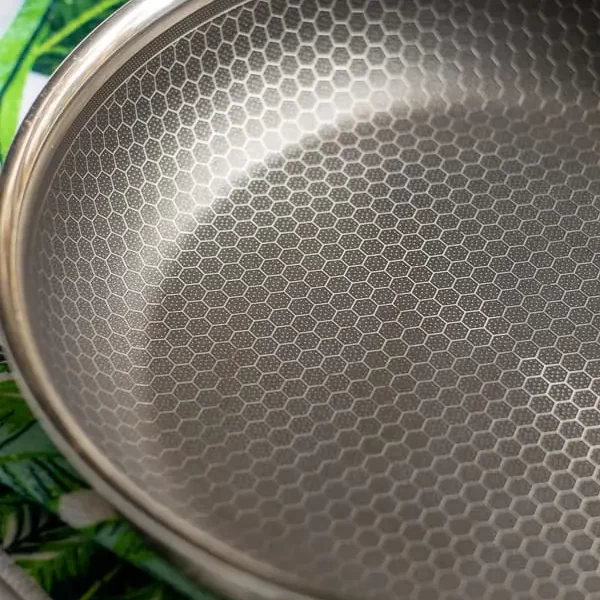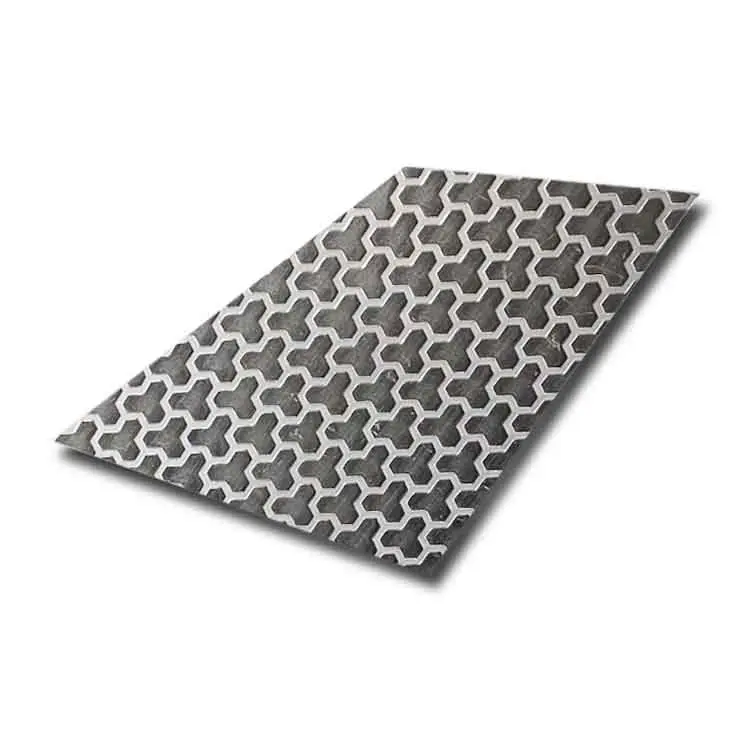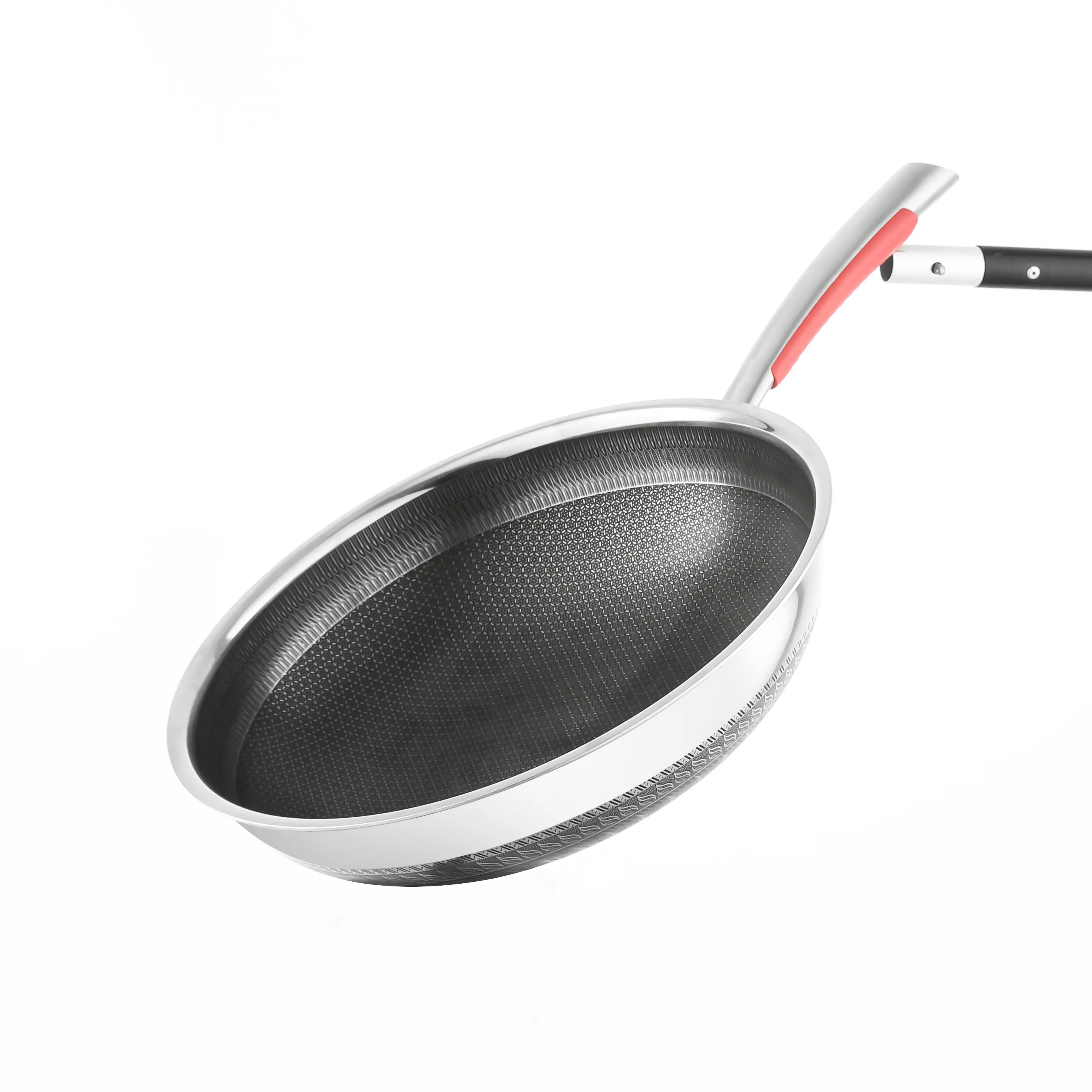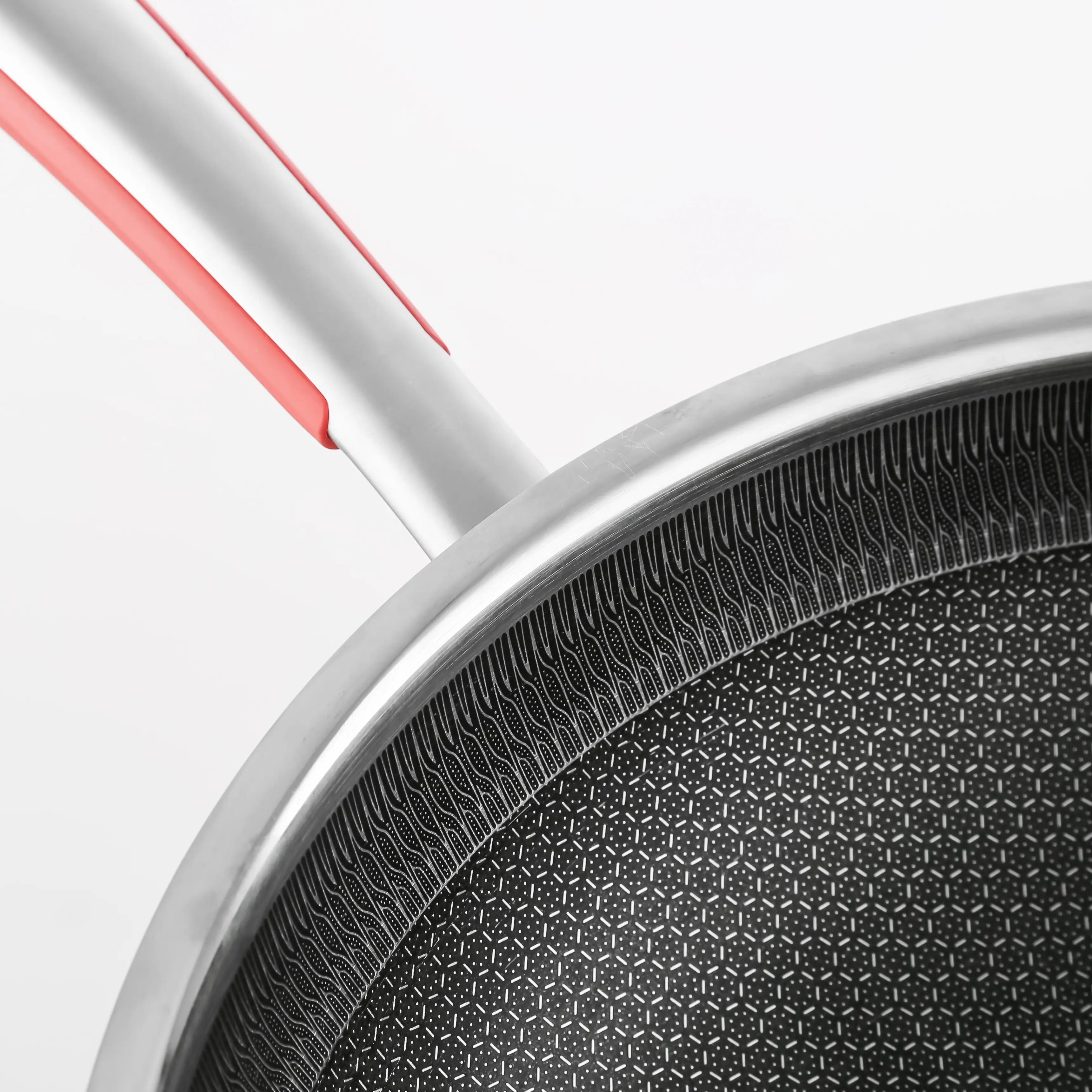
긁힌 논스틱 코팅, 박리된 표면, 짧은 제품 수명. 이런 성가신 문제에 직면한 적이 있으신가요? 다행히도, 허니콤 조리기구 는 중간 지점을 약속합니다. 논스틱의 편리함과 스테인리스 스틸의 내구성 및 내열 성능을 결합한 제품입니다.
이 글에서 헝광은 선도적인 스테인리스 스틸 조리기구 제조업체에서는 벌집 표면이 어떻게 만들어지는지, 왜 다르게 작동하는지, 언제 벌집 표면이 더 나은 선택인지 설명합니다.
허니콤 조리기구란 무엇인가요?
허니콤 조리기구 는 일반적으로 레이저 에칭 기술로 제작되는 미세한 질감의 금속 표면을 사용하여 작은 오목한 셀("벌집")의 격자를 만듭니다. 이 텍스처는 스테인리스 스틸 표면(텍스처 스테인리스 스틸)을 그대로 드러내거나 오목한 부분에 보호용 논스틱 코팅이 유지되고 돌출된 금속 리브가 마모로부터 보호하는 하이브리드 형태일 수 있습니다. 일반적인 구조는 이 레이저 에칭 텍스처 표면과 다중 플라이 바디(예: 3겹 또는 5겹)를 결합하여 열을 더 잘 분산시킵니다.
벌집의 제조 방법
세 가지 일반적인 표준 제조 프로세스가 있습니다:
- 레이저 에칭/레이저 제거: 스테인리스 표면에 정밀하고 반복 가능한 마이크로 셀을 에칭합니다. 우수한 깊이 제어 및 패턴에 적합합니다.
- 화학적 에칭: 일부 지오메트리의 경우 저렴하지만 깊이 제어가 떨어집니다.
- 기계식 엠보싱: 금속에 패턴을 밀어 넣는 방식으로 빠르지만 표면 변형이 발생할 수 있습니다.
에칭 후 제조업체는 오목한 셀을 얇은 논스틱 코팅(PTFE 또는 세라믹)으로 채우거나 금속을 노출(일렉트로 폴리싱)할 수 있습니다. 에칭 깊이 균일성, 접착력 테스트(코팅 사용 시), 표면 거칠기(Ra) 측정이 제어 요소입니다.

일반 논스틱 조리기구와의 기술적 차이점
표면 보호 및 내마모성
- 허니콤: 돌출된 금속 리브는 주걱으로 인한 접촉을 대부분 흡수하며, 코팅이 되어 있으면 논스틱이 빈 공간에 보호됩니다. 이렇게 하면 코팅의 직접적인 마모를 크게 줄일 수 있습니다.
- 일반 논스틱: 코팅은 평평한 기판 위에 놓여 있고 직접 노출되어 있습니다. 따라서 한 번만 세게 긁어도 박리가 시작될 수 있습니다.
스크래치 및 마모 수명
- 허니콤: 마모에 대한 저항력이 훨씬 더 뛰어납니다. 실제 테스트에서 하이브리드 허니콤 팬은 금속 도구를 사용해도 이형 특성이 더 오래 유지되는 것으로 나타났습니다(금속 도구는 여전히 권장하지 않습니다).
- 논스틱: 이 조리기구는 초기 방출이 빠르지만 마모와 고열 노출로 인해 성능이 저하됩니다.
열 성능 및 시어링
- 멀티플 위에 벌집 모양: 스테인리스 스틸의 시어링 기능은 그대로 유지됩니다.
- 논스틱: 플랫 코팅은 달라붙는 것을 방지하지만 고온에 그을림(코팅 열화 위험)을 제한합니다.
초기 출시 및 조리 느낌
- 허니콤: 오일과 기술로 초기 이형 성능이 향상되며, 마이크로셀이 얇은 유막을 형성하여 이형에 도움을 줍니다. 새 PTFE처럼 항상 "즉각적인 이형"은 아니지만 안정적으로 양호합니다.
- 논스틱: 매우 섬세한 음식(달걀, 생선)은 새것일 때 가장 효과적이며 시간이 지날수록 효과가 떨어집니다.
안전 및 고온 복원력
- 허니콤: 코팅이 덜 노출되므로 코팅이 파손될 위험이 적습니다. 질감이 있는 스테인리스 기판은 더 높은 온도에서도 안전하게 견딜 수 있습니다.
- 논스틱: 매우 높은 온도에서 일부 코팅은 인체에 유해한 물질을 분해할 수 있으므로 과열되지 않도록 주의하세요.
구매 가이드: 양질의 허니콤 조리기구를 고르는 방법
이러한 사양과 테스트를 찾아보세요:
소재 및 등급: 304/18-10 스테인리스(또는 동급)로 만든 내부 조리 표면. 열 균일성을 위한 멀티플라이(3겹 또는 5겹) 코어.
에칭 품질: 일관된 에칭 깊이와 균일한 셀 크기. 현미경 사진 또는 QC 보고서를 요청하세요.
코팅 접근 방식: 코팅되지 않은 질감의 스테인리스(내구성, 오일 필요)와 코팅된 하이브리드(초기 이형성 향상) 중에서 결정합니다. 코팅된 경우 접착력 및 마모 테스트 결과를 요청하세요.
베이스 및 두께: 무겁고 완전히 덮인 베이스는 뒤틀림에 강합니다. mm 허용 오차를 지정합니다.
호환성: 필요한 경우 인덕션 지원 베이스.
테스트 문서: 열 순환, 스크래치/마모 테스트, 샘플 조리 테스트(달걀, 시어 테스트). B2B 구매자의 경우 실험실 테스트 보고서를 요청하세요.
의사 결정 매트릭스
| 사용자 유형/요구 사항 | 허니콤 조리기구 선택 | 기존 논스틱 선택 |
|---|---|---|
| 내구성 및 수명 | 오래 지속되는 내마모성 ✔ 내마모성 | 서비스 수명 단축 |
| 요리 스타일 | 시어링, 브라우닝 및 탈유약에 이상적입니다. | 섬세하고 저지방 요리에 적합 |
| 사용 빈도 | 사용 빈도가 높은 가정 또는 상업용 주방에 적합 | 가벼운 요리나 가끔씩 하는 요리에 적합 |
| 유지 관리 | 손쉬운 세척, 질감으로 보호되는 코팅 | 긁힘을 방지하기 위해 부드러운 관리가 필요합니다. |
| 무게 | 보통 - 스테인리스 스틸 베이스가 무게를 더합니다. | 매우 가볍고 다루기 쉬움 |
| 내열성 | 우수 - 고온을 견딤 | 제한적 - 고열에서 코팅이 저하됨 |
| 최상의 대상 | 가정 요리사, 레스토랑, OEM 바이어 | 편의성을 중시하는 일상 사용자 |
관리 및 유지보수
- 스틸 울과 거친 연마재는 피하세요. 부드러운 스펀지나 나일론 브러시를 사용하세요.
- 실리콘 또는 나무 주걱을 선호합니다. 돌출된 갈비뼈와 코팅이 더 부드럽습니다.
- 끓는 물로 탄 찌꺼기 청소하기 (물을 넣고 끓인 후 플라스틱 주걱으로 부드럽게 긁어냅니다.) 또는 잘 지워지지 않는 찌꺼기는 베이킹소다 페이스트를 사용합니다.
- 코팅하지 않은 경우, 청소 후 가벼운 오일 시즈닝을 하면 릴리스 성능이 향상되고 벌집 논스틱 표면을 보호할 수 있습니다.
결론
허니콤 쿡웨어는 속임수가 아니라 코팅 수명을 연장하고 내마모성을 개선하며 많은 요리사가 중요하게 여기는 스테인리스 타지 않는 특성을 보존하는 목적 중심의 엔지니어링 솔루션입니다. 공급업체와 조달 관리자의 경우 허니콤 팬은 보증 클레임을 줄이고 고객 만족도를 높입니다. 가정 요리사와 셰프에게는 교체 횟수가 줄어들고 실제 사용 시 성능이 향상됩니다.
헝광 소개

헝광은 선도적인 허니콤 논스틱 조리기구 제조업체프리미엄 전문 3중 스테인리스 스틸 조리도구 고른 열 분배, 지속적인 내구성, 세련된 미관을 보장합니다. 각 제품은 가정과 전문 주방의 요구 사항을 모두 충족할 수 있도록 정밀하게 제작되었습니다.
자주 묻는 질문
Q: 허니콤 조리기구가 정말 내구성이 더 뛰어난가요?
A: 예. 에칭 처리된 스테인리스 스틸 격자는 조리기구와 과도한 사용으로부터 코팅을 보호해 레스토랑과 호텔 주방에 이상적입니다.
Q: 대용량 요리도 더 잘 처리하나요?
A: 물론입니다. 허니콤 조리기구 는 열, 긁힘, 세척 화학 물질에 강해 회전율이 일정한 상업용 주방에 적합합니다.
Q: 일반 넌스틱 팬보다 유지 관리가 쉽나요?
A: 예, 하지만 스마트 케어가 도움이 됩니다. 부드러운 스펀지로 빠르게 담가두면 장시간 사용 후에도 거칠게 문지르지 않아도 깨끗하게 유지됩니다.
Q: 허니콤 조리기구는 가족이 일상적으로 사용하기에 안전한가요?
A: 예. PFOA가 없는 식품 등급 스테인리스 스틸로 고열에서도 안전하며, 매일 굽거나 기름을 적게 사용하는 요리에 적합합니다.
Q: 집에서 금속 식기를 사용해도 되나요?
A: 예, 부드럽게 하지만 권장하지는 않습니다. 스테인리스 격자가 코팅을 보호하지만 칼이나 날카로운 모서리를 피하여 안전하게 보관하세요. 벌집 조리기구 새로운 모습으로.

